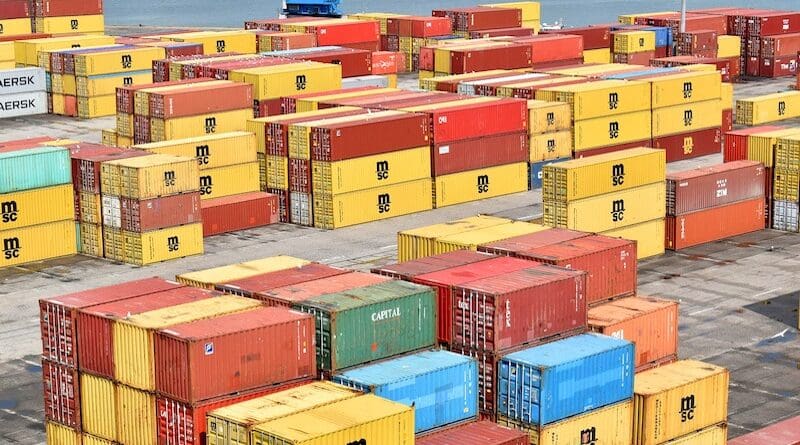Filling The US-Shaped Hole In World Trade – Analysis
By Richard Pomfret
The world trade system has been challenged by tariff increases introduced by former US president Donald Trump and maintained by President Joe Biden, and by both candidates’ commitments to increase US tariffs further after the 2024 election. Both presidents have also undermined the effectiveness of the World Trade Organization (WTO) by neutering the dispute settlement mechanism and withdrawing from efforts to improve and extend world trade law.
One of Trump’s first actions in January 2017 was to withdraw the United States from the Trans-Pacific Partnership (TPP). The Trump administration also refused to approve new members of the WTO Appellate Body, allowing lost cases to be appealed into the void. These steps halted the most viable institution for extending world trade law among like-minded trading nations and undermined the enforcement of current international trade law. After Biden was inaugurated in January 2021, he quickly made clear that he would not reverse the US position on either of these issues.
Extension of world trade law is essential because the world trade system has gone through major changes since 1995 when the internet was in its infancy. But the consensus requirement has stymied WTO reform.
The United States under former presidents George W Bush and Barack Obama led the way in designing the TPP, a non-discriminatory agreement signed in 2016 under which like-minded countries extended WTO law. Obama made his reason for negotiating the TPP clear when he said in 2015 that ‘we have to make sure the United States — and not countries like China — is the one writing this century’s rules for the world’s economy’.
After the United States failed to ratify the TPP, the 11 other signatories proceeded with the slightly revised Comprehensive and Progressive Agreement for Trans-Pacific Partnership (CPTPP), which came into effect in 2018.
Much of the CPTPP’s agenda is shared by the European Union in its own trade agreements, and by Southeast Asian countries unwilling to go all-in on the CPTPP but committed to the Regional Comprehensive Economic Partnership (RCEP). The United Kingdom joined the CPTPP in June 2023. China and Taiwan are next in the queue for accession, followed by other Asian and South American countries.
As an alternative appeal process, in 2020 47 WTO members, including Australia, Canada, China and the European Union created the Multi-Party Interim Appeal Arbitration Arrangement (MPIA), whose signatories recognise binding arbitration on disputed decisions of the WTO’s dispute settlement body.
Further responses were hampered by the COVID-19 pandemic, which curtailed face-to-face meetings in 2020 and 2021. In 2023, the number of MPIA members increased when Japan became the 53rd MPIA signatory. The MPIA’s credibility was augmented when China accepted a WTO decision in a dispute with Australia after the MPIA raised the prospect of losing an appeal.
Despite these efforts to overcome US inaction, the downgrading of the WTO as the institution setting world trade law and resolving disputes makes it harder to address other trade issues, such as the trade aspects of industrial policy and other subsidies. In April 2022, the IMF, the OECD, the World Bank and the WTO published an explicit plea for a renewed work program and policymaker engagement on industrial policy. Balancing trade policies with the global imperative of addressing climate change and implementing border adjustments to address differing carbon taxes are other urgent topics.
World trade has flourished in 2022 and 2023 as economies recovered from the COVID-19 pandemic. But the system of trade law that has grown out of the WTO has been threatened by the transformation of US attitudes since 2016. Other major trading nations are working to extend world trade law and strengthen compliance so that, even without US collaboration, they can realise greater gains from trade.
If a new institutional order for global trade based on an expanded CPTPP emerges, and if RCEP members and the European Union commit to compatibility, then the global economy will continue to function, but with different levels of commitment to trade rules. CPTPP and RCEP members and EU countries will observe the highest standard world trade rules and accept dispute resolution processes. A second group — India, South Africa and many developing economies — will accept current WTO rules, but no more. A third group — countries like North Korea — will have no interest in being bound by world trade rules at all.
On their post-2017 record, the United States could be in any of these three groups.
The actions of other trading nations matter. The larger the group of important trading nations accepting CPTPP rules, the greater the incentive for the United States to re-join the process of trade lawmaking. Out of a world GDP of US$106 trillion in 2023, the United States accounted for 25 per cent, China 18 per cent, the European Union’s 27 nations 16 per cent and the CPTPP’s 12 nations 15 per cent. The next largest economies — India 4 per cent, Brazil 2 per cent, and Russia 2 per cent — lagged far behind.
The European Union, CPTPP members, plus China and other Asian countries intending to join the CPTPP account for over half of global output. Together they are a persuasive force, but a reversal of US attitudes towards global trade rules will likely have to wait until after the presidential election in November 2028.
- About the author: Richard Pomfret is Adjunct Professor of International Economics at The Johns Hopkins University SAIS Europe in Bologna, Italy, and Professor of Economics Emeritus at the University of Adelaide.
- Source: This article was published by East Asia Forum

